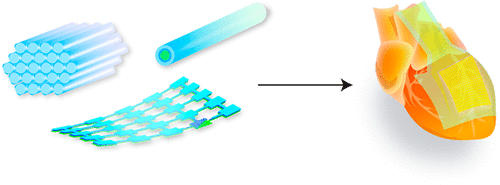当前位置:
X-MOL 学术
›
Acc. Mater. Res.
›
论文详情
Our official English website, www.x-mol.net, welcomes your
feedback! (Note: you will need to create a separate account there.)
Nanoenabled Bioelectrical Modulation
Accounts of Materials Research ( IF 14.0 ) Pub Date : 2021-08-30 , DOI: 10.1021/accountsmr.1c00132 Aleksander Prominski 1, 2, 3 , Pengju Li 4 , Bernadette A Miao 1 , Bozhi Tian 1, 2, 3
Accounts of Materials Research ( IF 14.0 ) Pub Date : 2021-08-30 , DOI: 10.1021/accountsmr.1c00132 Aleksander Prominski 1, 2, 3 , Pengju Li 4 , Bernadette A Miao 1 , Bozhi Tian 1, 2, 3
Affiliation

|
Studying the formation and interactions between biological systems and artificial materials is significant for probing complex biophysical behaviors and addressing challenging biomedical problems. Bioelectrical interfaces, especially nanostructure-based, have improved compatibility with cells and tissues and enabled new approaches to biological modulation. In particular, free-standing and remotely activated bioelectrical devices demonstrate potential for precise biophysical investigation and efficient clinical therapies. Interacting with single cells or organelles requires devices of sufficiently small size for high resolution probing. Nanoscale semiconductors, given their diverse functionalities, are promising device platforms for subcellular modulation. Tissue-level modulation requires additional consideration regarding the device’s mechanical compliance for either conformal contact with the tissue surface or seamless three-dimensional (3D) biointegration. Flexible or even open-framework designs are essential in such methods. For chronic organ integration, the highest level of biocompatibility is required for both the materials and device configurations. Additionally, a scalable and high-throughput design is necessary to simultaneously interact with many individual cells in the organ. The physical, chemical, and mechanical stabilities of devices for organ implantation may be improved by ensuring matching of mechanical behavior at biointerfaces, including passivation or resistance designs to mitigate physiological impacts, or incorporating self-healing or adaptative properties.
中文翻译:

纳米生物电调制
研究生物系统和人造材料之间的形成和相互作用对于探索复杂的生物物理行为和解决具有挑战性的生物医学问题具有重要意义。生物电界面,尤其是基于纳米结构的界面,提高了与细胞和组织的兼容性,并为生物调制提供了新的方法。特别是,独立和远程激活的生物电子设备展示了精确生物物理研究和有效临床治疗的潜力。与单个细胞或细胞器相互作用需要足够小的尺寸来进行高分辨率探测。纳米级半导体具有多种功能,是用于亚细胞调制的有前途的设备平台。组织水平调制需要额外考虑设备的机械顺应性,以便与组织表面保形接触或无缝三维 (3D) 生物整合。在这种方法中,灵活甚至开放的框架设计是必不可少的。对于慢性器官整合,材料和设备配置都需要最高水平的生物相容性。此外,需要可扩展的高通量设计才能同时与器官中的许多单个细胞相互作用。通过确保生物界面机械行为的匹配,包括钝化或电阻设计以减轻生理影响,或结合自愈或自适应特性,可以提高器官植入装置的物理、化学和机械稳定性。
更新日期:2021-10-22
中文翻译:

纳米生物电调制
研究生物系统和人造材料之间的形成和相互作用对于探索复杂的生物物理行为和解决具有挑战性的生物医学问题具有重要意义。生物电界面,尤其是基于纳米结构的界面,提高了与细胞和组织的兼容性,并为生物调制提供了新的方法。特别是,独立和远程激活的生物电子设备展示了精确生物物理研究和有效临床治疗的潜力。与单个细胞或细胞器相互作用需要足够小的尺寸来进行高分辨率探测。纳米级半导体具有多种功能,是用于亚细胞调制的有前途的设备平台。组织水平调制需要额外考虑设备的机械顺应性,以便与组织表面保形接触或无缝三维 (3D) 生物整合。在这种方法中,灵活甚至开放的框架设计是必不可少的。对于慢性器官整合,材料和设备配置都需要最高水平的生物相容性。此外,需要可扩展的高通量设计才能同时与器官中的许多单个细胞相互作用。通过确保生物界面机械行为的匹配,包括钝化或电阻设计以减轻生理影响,或结合自愈或自适应特性,可以提高器官植入装置的物理、化学和机械稳定性。











































 京公网安备 11010802027423号
京公网安备 11010802027423号